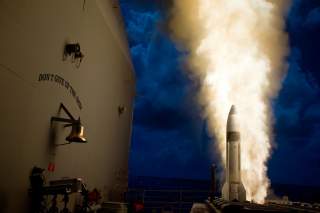The U.S. Navy Needs to Do Missile-Defense Differently
Destroyers and cruisers with BMD sensors and weapons are too few and their missile capacities too small effectively to defend land bases, Paul James wrote in Proceedings, the professional journal of the U.S. Naval Institute.
The U.S. Navy should rethink its approach to the ballistic-missile-defense mission, one retired Navy officer advised.
Destroyers and cruisers with BMD sensors and weapons are too few and their missile capacities too small effectively to defend land bases, Paul James wrote in Proceedings, the professional journal of the U.S. Naval Institute.
James echoed comments retired admiral John Richardson, then the chief of naval operations, made in 2018. Richardson complained that six of his 38 BMD-capable vessels were assigned to missile-defense stations and realistically were not available for other assignments.
“Right now, as we speak, I have six multi-mission, very sophisticated, dynamic cruisers and destroyers―six of them are on ballistic missile defense duty at sea,” Richardson said. “You have to be in a tiny little box to have a chance at intercepting that incoming missile. So, we have six ships that could go anywhere in the world, at flank speed, in a tiny little box, defending land.”
James agreed that committing BMD ships to patrol stations is a waste of resources. “There will never be enough Aegis cruisers and destroyers to meet all operational requirements,” James wrote.
“This means commanders must assess risk, establish priorities and allocate resources accordingly. Facing peer or near-peer adversaries, commanders will be required to employ surface combatants when and where they are most needed and will need the flexibility to redeploy them when threats change or opportunities arise. Limiting ships to a single mission in a small geographic area is an inefficient use of a multimission asset and not justifiable when viable alternatives exist.”
Those alternatives are land-based ballistic-missile-defense systems such as Aegis Ashore and the U.S. Army’s Terminal High-Altitude Area Defense and Ground-Based Defense missiles.
Aegis Ashore is a land-based version of the BMD system the Navy uses. It features the same Aegis radar system and the same SM-3 interceptor missile. THAAD is a mobile surface-to-air missile system that, like Aegis Ashore, can hit slower ballistic missiles in the final seconds of flight. GBD is a ICBM-like rocket that can strike a large, fast-moving ballistic missile at the mid-point of its flight when the missile is outside the atmosphere.
The U.S. Missile Defense Agency maintains Aegis Ashore sites in Poland and Romania to defend against Iranian ballistic missiles. The Army deploys THAAD batteries on demand to protect ground installations. The Army operates fixed GBD bases in Alaska and California to defend against attacks from North Korea.
Ground-based defenses could pack more missiles than a ship can. “Potential adversaries are fielding missiles of increased range, accuracy, flexibility and survivability,” James pointed out. “But beyond the impressive technological improvements, these weapons are being fielded in staggering numbers.”
U.S. adversaries possess extensive inventories of short- and medium-range ballistic missiles. With China and Russia, ballistic missile forces are complemented by an equal or perhaps greater number of land-attack cruise missiles.
Against these numbers, by 2020 the U.S. Navy will have fewer than 400 Standard Missile (SM)-3s, of which 150 will be the older SM-3 Block I or IA (some nearing retirement age). There will be more SM-6s, but their BMD requirements will have to compete with those for air defense and anti-surface warfare.
Furthermore, the available Navy-wide SM-3 and SM-6 inventory has to be divided among the various geographic combatant commands and must compete for shipboard vertical launch system space with SM-2 and Tomahawk land-attack missiles.
In most cases, a single ship faces an unsolvable math problem. BMD patrols do deter adversaries and reassure allies of U.S. commitment. But the Navy is writing a check it cannot cash. This might be acceptable if there were no alternative. However, defending static land-based assets can be better accomplished by land-based BMD systems.
The Navy should shift to a new operating concept for missile-defense, where its ships focus on protecting aircraft carriers and amphibious groups against ballistic anti-ship missiles, James recommended. He pointed out that the Navy’s BMD force, which is on track to grow to around 60 vessels, also could function as a reserve, capable of surging into a war zone in order to reinforce land-based missile-defenses.

